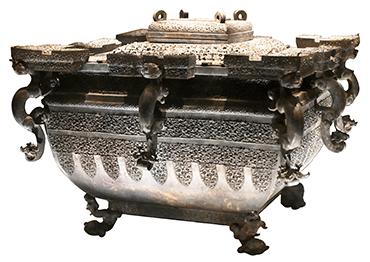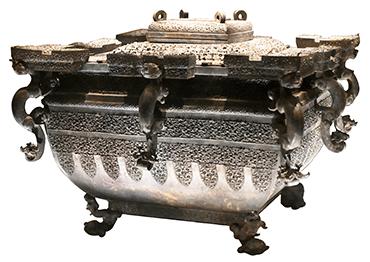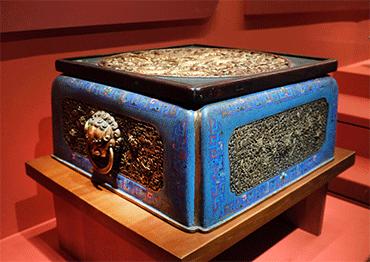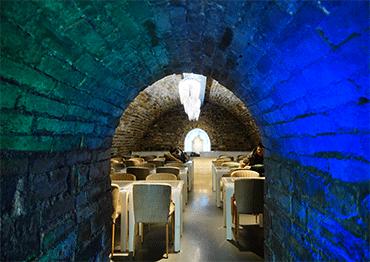Held at the National Museum of China in Beijing, the artifacts were unearthed in 1978 from the Marquis’ tomb in Sui County, Hubei. Exceptionally well-preserved, the set consists of two main vessels: an outer bronze ice storage container and a smaller inner wine vessel.
The sides of the square outer container, or jian in Chinese, are adorned with coiled dragon patterns, while the lower part is decorated with hanging leaf patterns. Inside the lid is an inscription: “Owned by Zeng Houyi (Marquis Yi) for personal use.”
While the jian contained ice, the inner bronze vessel, called the fou, most often contained wine but was sometimes used for food. When fitted together, the gap between allows for ice to surround the inner fou.
This bronze fridge could also double as a sort of hotplate. In winter, the jian was filled with hot water or coals to keep the food inside piping hot. All this makes sense, as Marquis Yi was evidently a real foodie.
Among the burial items found in his tomb, archaeologists discovered a large quantity of utensils with traces of food and seasoning. For example, there was a bronze fish-grilling plate with charcoal underneath. It even had the boney remains of a carp.
Additionally, there were two large bronze containers filled with fish bones and Sichuan peppercorns, indicating Marquis Yi’s particular fondness for fish dishes.
Grilled fish was especially popular during autumn and winter, but a nono in summer according to traditional Chinese medicine, as the dish increases “internal heat.” This apparently did not deter a man of means like the Marquis. After all, he was drinking iced summer wine over 2,000 years ago.
But he was not the only one. During the late Warring States Period, records tell that nobles in the neighboring State of Chu were also drinking ice-chilled beverages in summer – and it was a status symbol. “Chilled, fragrant frozen drinks are not for the common people,” reads a verse from the ancient poetry anthology Elegies of Chu.
Another innovation was a mini cooler known as an “ice pot.” Crushed ice was placed inside a jade pot, which nobles held or placed on the body. By the Tang Dynasty (618-907), ice pots were already common among the upper class.
The family of Tang prime minister Yang Guozhong (served from 752-756) would order large ice blocks to be carved out of mountains in midsummer and have them delivered to the palace to be placed around banquet tables. It is recorded that on occasion, guests felt so cold during the feast that they had to wear winter clothes.
Yang’s family had the ice blocks carved into exotic creatures, adorned with gold rings and jade belts, and presented them to invited dignitaries in order to win their favor.
But this does not compare to Song Dynasty Emperor Xiaozong (1127- 1194) who, sick of the stiffing summer heat, ordered his servants to build an “ice palace.” Doing the best they could, they planted evergreens and bamboo all around the palace and surrounded it with streams of cold spring water. Inside, they covered the palace with large bowls filled with ice. In another strong craving for cool, Song Emperor Huizong (1082-1135) ate so much ice that, according to an ancient medical text, he developed a spleen disorder.
Kublai Khan, grandson of Ghengis Khan and founder of the Yuan Dynasty (1271-1368), was undeterred by this possibility, as he was known to have feasted on iced milk treats in summer. Fruit preserves and jams were added, creating a predecessor to ice cream. Similar to Song aristocrats, Kublai Khan wanted icy desserts for the elite only and kept the recipe a secret. He even issued a decree that no one except the royal family could make them.
Then there is the icebox. The Palace Museum in Beijing houses a wooden one made during the Qing Dynasty (1644-1911). The exterior is cypress wood, and inside there are drawers. On hot summer days, ice blocks were placed under the drawers, while food was placed on the shelves above. The interior is insulated with sheets of lead, something that would have never passed safety checks today.

 Old Version
Old Version


